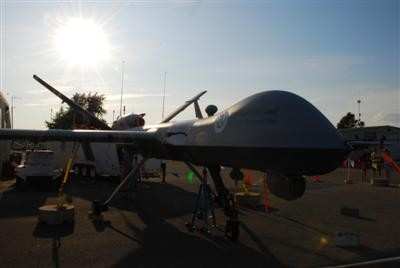Tue, May 25, 2010
Hopes To Use The Aircraft To Catch Illegal Immigrants,
Smugglers
 The U.S. Customs and Border Protection service (CBP) has
requested authority to expand their use of UAV's in Texas, notably
to fly along the gulf coast and the Rio Grande.
The U.S. Customs and Border Protection service (CBP) has
requested authority to expand their use of UAV's in Texas, notably
to fly along the gulf coast and the Rio Grande.
U.S. Representative Henry Cuellar (D-Laredo) hosted a meeting
late last week between FAA Administrator Babbitt and the CBP. The
Austin America Statesman reports that, following the meeting,
Cuellar expects that the new UAV will be approved by summer and in
operation by fall of this year. The aircraft would be based in
Corpus Christi.
"Last week, FAA gave CBP approval to fly from Arizona to West
Texas, and now we need clearance for the remaining 1,200 miles of
the Texas southern border," Cuellar (pictured, below) said in
a statement on his Congressional website. "These aircraft will
increasingly become a familiar means for providing homeland
security. The real time intelligence they provide will benefit our
domestic security strategy and give us a new tool to meet the
evolving threats of the 21st century. CBP has a vision to expand
this border security program and Texas is a part of that plan."

Currently, CBP Air and Marine operate several Predator B
unmanned aircraft systems along the northern and southern borders
of the United States. These remotely piloted aircraft have a long
duration of flight, up to 20-30 hours, and have provided to the
Department of Homeland Security critical national intelligence
information to secure the nation’s land borders. The new
CBP-operated UAV would provide real-time actionable information to
border patrol agents on the ground. This would allow border patrol
agents to immediately deploy response vehicles, boats, helicopters
or other aircraft to security situations along the border, as is
border security practice in other southern border states where UAVs
operate.
Pending FAA approval, the remotely-piloted aircraft could
provide CBP with air, land and marine intelligence to combat
illegal activity along the Rio Grande and Texas coastal waters
along the Gulf of Mexico. If the flight track is approved by the
FAA, CBP would have the operational capability to deploy a Predator
B land-based aircraft or a dual purpose land-marine Guardian
Maritime aircraft to the Texas-Mexico border this year.

Texas officials have long advocated the use of UAV's to patrol
the border, and the FAA's primary objection has always been safety
issues. "The FAA has moved cautiously in this area because of
concerns about the ability of these aircraft to operate in an
environment where other nonmilitary aircraft are present," FAA
spokesman Lynn Lunsford said.
More News
Terminal Radar Service Area Airspace surrounding designated airports wherein ATC provides radar vectoring, sequencing, and separation on a full-time basis for all IFR and participa>[...]
Very High Frequency (VHF) The frequency band between 30 and 300 MHz. Portions of this band, 108 to 118 MHz, are used for certain NAVAIDs; 118 to 136 MHz are used for civil air/grou>[...]
“From approximately November 2021 through January 2022, Britton-Harr, acting on behalf of AeroVanti, entered into lease-purchase agreements for five Piaggio-manufactured airc>[...]
Also: Virtual FLRAA Prototype, IFR-Capable Autonomous A/C, NS-32 Crew, Golden Dome Missile Defense Bombardier announced that the first production Global 8000 successfully completed>[...]
Aero Linx: The 1-26 Association (Schweizer) The Association’s goal is to foster the helpfulness, the camaraderie, and the opportunity for head-to-head competition that is fou>[...]
 ANN's Daily Aero-Term (05.29.25): Terminal Radar Service Area
ANN's Daily Aero-Term (05.29.25): Terminal Radar Service Area ANN's Daily Aero-Term (05.30.25): Very High Frequency (VHF)
ANN's Daily Aero-Term (05.30.25): Very High Frequency (VHF) Aero-News: Quote of the Day (05.30.25)
Aero-News: Quote of the Day (05.30.25) Airborne 05.23.25: Global 8000, Qatar B747 Accepted, Aviation Merit Badge
Airborne 05.23.25: Global 8000, Qatar B747 Accepted, Aviation Merit Badge ANN's Daily Aero-Linx (05.30.25)
ANN's Daily Aero-Linx (05.30.25)





